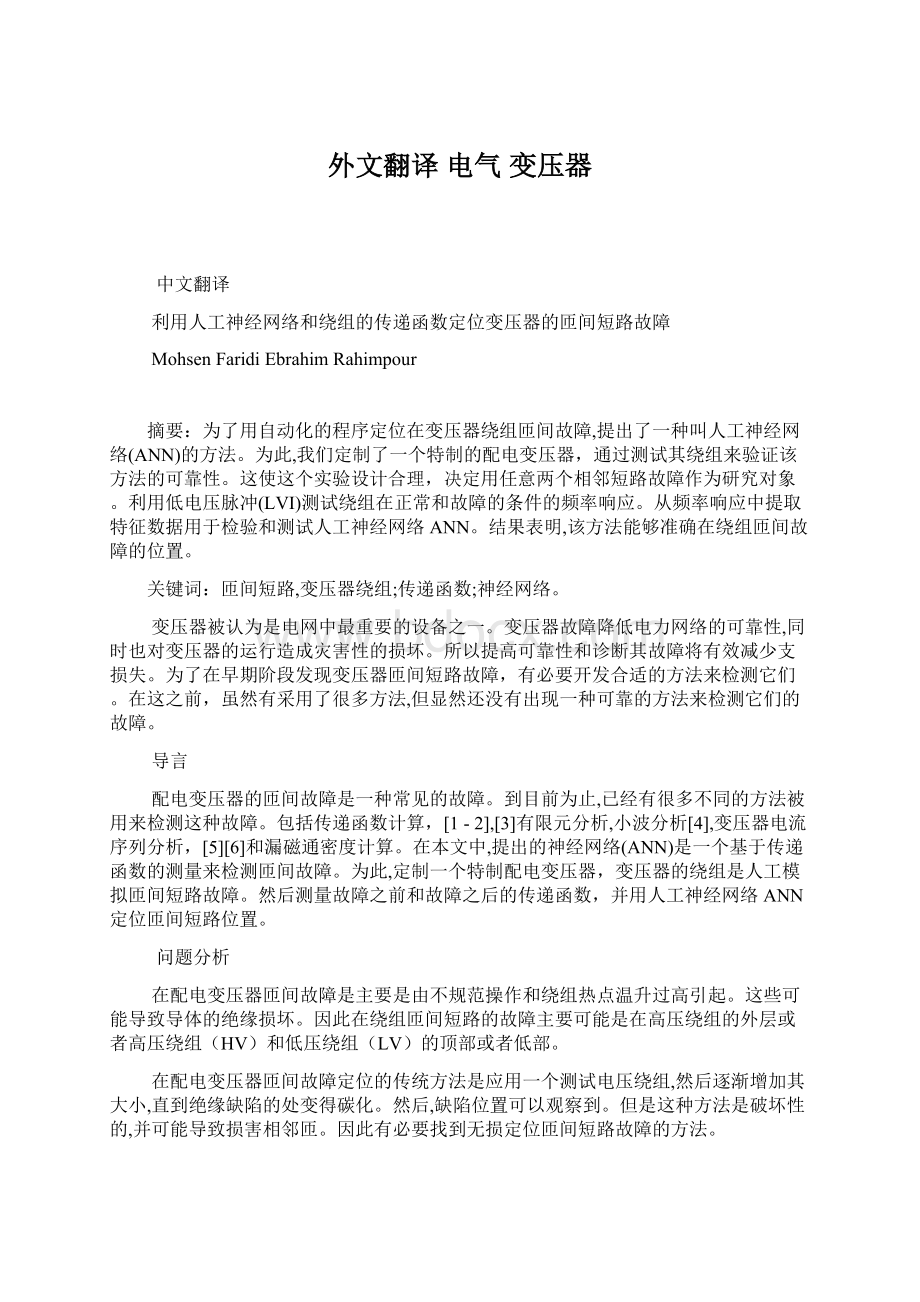外文翻译 电气 变压器.docx
《外文翻译 电气 变压器.docx》由会员分享,可在线阅读,更多相关《外文翻译 电气 变压器.docx(16页珍藏版)》请在冰豆网上搜索。

外文翻译电气变压器
中文翻译
利用人工神经网络和绕组的传递函数定位变压器的匝间短路故障
MohsenFaridiEbrahimRahimpour
摘要:
为了用自动化的程序定位在变压器绕组匝间故障,提出了一种叫人工神经网络(ANN)的方法。
为此,我们定制了一个特制的配电变压器,通过测试其绕组来验证该方法的可靠性。
这使这个实验设计合理,决定用任意两个相邻短路故障作为研究对象。
利用低电压脉冲(LVI)测试绕组在正常和故障的条件的频率响应。
从频率响应中提取特征数据用于检验和测试人工神经网络ANN。
结果表明,该方法能够准确在绕组匝间故障的位置。
关键词:
匝间短路,变压器绕组;传递函数;神经网络。
变压器被认为是电网中最重要的设备之一。
变压器故障降低电力网络的可靠性,同时也对变压器的运行造成灾害性的损坏。
所以提高可靠性和诊断其故障将有效减少支损失。
为了在早期阶段发现变压器匝间短路故障,有必要开发合适的方法来检测它们。
在这之前,虽然有采用了很多方法,但显然还没有出现一种可靠的方法来检测它们的故障。
导言
配电变压器的匝间故障是一种常见的故障。
到目前为止,已经有很多不同的方法被用来检测这种故障。
包括传递函数计算,[1-2],[3]有限元分析,小波分析[4],变压器电流序列分析,[5][6]和漏磁通密度计算。
在本文中,提出的神经网络(ANN)是一个基于传递函数的测量来检测匝间故障。
为此,定制一个特制配电变压器,变压器的绕组是人工模拟匝间短路故障。
然后测量故障之前和故障之后的传递函数,并用人工神经网络ANN定位匝间短路位置。
问题分析
在配电变压器匝间故障是主要是由不规范操作和绕组热点温升过高引起。
这些可能导致导体的绝缘损坏。
因此在绕组匝间短路的故障主要可能是在高压绕组的外层或者高压绕组(HV)和低压绕组(LV)的顶部或者低部。
在配电变压器匝间故障定位的传统方法是应用一个测试电压绕组,然后逐渐增加其大小,直到绝缘缺陷的处变得碳化。
然后,缺陷位置可以观察到。
但是这种方法是破坏性的,并可能导致损害相邻匝。
因此有必要找到无损定位匝间短路故障的方法。
根据绕组匝间短路故障的模型参数的影响和传递函数的测量和分析来诊断匝间短路时合理的。
在这个研究上电压转移和转移导纳函数是用来定位匝间短路故障。
测试绕组的特性
在这个工作电压转移和转移导纳函数是用来定位匝间短路故障
图1显示了专门准备的绕组20/0.4KV,原理图50kva变压器用于进行实验测试。
层类型高压绕组由15层。
到第31个接头,更有可能变成匝间短路故障。
因为短路选取两个接头产生匝间短路缺陷。
考虑到选取的邻近两个匝间的距离,在查查寻过程中找到84匝人工匝间短路模型。
图1检测电路和测量系统
两个不同的频率响应测量的目的故障定位。
图2显示了测量的测试电路转移导纳函数。
在这个电路低压(LV)绕组短路的和中性的高压绕组接地通过50Ω阻力。
一连串的低压脉冲用于激励高压侧线圈。
高压侧电压及其中性电流测量在时间域分别作为输入和输出信号。
利用傅里叶变换计算测量信号的导纳来得出传递函数。
Io和Vi分别是接地电流和外加电压。
图2.测试导纳的电路图
图3.测量转移电压的电路图
图4.试验设备
在图3的测试电路测量电压传递函数。
在这个电路中,接线柱的高压和低压绕组接地直接和脉冲应用于高压终端。
电压转移函数计算使用的傅里叶变换测量高压和低压电压:
V0和Vi是对低压绕组LV的电压传输和高压绕组的应用。
应用低压脉冲有10个ns倍上升。
输入和输出信号使用数字示波器测量500msam/秒和105样本/记录。
完整的测试电路安排图4所示。
在图5中,转移导纳的测量输入和输出信号和传输电压测试电路圈所示的正常状况。
测量信号在测试电路第2和第4匝,第26匝和30匝的短路转身是短路如图6所示。
计算传递函数图6所示的信号提出了图7到10。
图,5正常情况下的绕组的信号输出
测量第2和第4之间还有第26和第30匝之间的短路故障情况下的输入和输出信号
图7.测量在正常运行时第26和第30匝之间的短路故障的传递导纳
图8.测量在正常运行时第2和第4匝之间的短路故障的传递导纳
图9.绕组的传递电压在正常情况下和第26和第30匝之间的短路故障。
图10.绕组的传递电压在正常情况下和第2和第4匝之间的短路故障。
人工神经网络智能算法可以学习之后一系列的训练模式和分类出新模式。
为了缺陷定位,两个相似的人工神经网络的具有反向学习算法得到应用。
16主导极点的振幅再计算电压转移和转移导纳函数作为这两个网络作为输入。
模拟匝间故障的结果,被分为两个组,一组用于训练网络,另一组用于测试。
这样,42匝间故障信息被用来测试ANN和其他42个错误被用来测试它。
所以,在训练阶段,两个42×16和42×1矩阵每个网络的应用作为输入和预期的输出。
用试错法,人工神经网络结构包括16,4和1神经元的输入,隐层和输出层,分别独立的。
得出人功智能网络(ANN)故障能准确合理的定位匝间短路故障。
图11.用ANN神经网络测试转移电压的结果
图12.用ANN神经网络测试传递导纳的结果
用人工神经网络定位
图11和图12显示的输出ANN的输入训练数据集和测试数据集分别传输电压和传输导纳函数。
可以看到,ANN学习模式和也能成功定位故障。
最大、最小和平均误差测试数据传输电压输入1.949,0.0065,0。
分别为825。
这些值在应用的情况传输导纳函数的输入是2.352,0.2502,0。
分别为7302。
也在这两种情况下,训练网络能够准确定位缺陷在95%缺陷位置的测试数据集。
结论
在这篇文章中,,提出了基于神经网络来定位匝间短路故障得方法。
这个网络使用特征值法提取传输电压和传输导纳函数的数据。
利用人工模拟变压器匝间短路故障的试验数据来训练ANN神经网络的定位故障。
结果由此证明利用神经网络ANN定位匝间的可行性。
LocalizationofTurn-to-TurnFaultinTransformers
UsingArtificialNeuralNetworksandWindingTransferFunction
MohsenFaridiIslamicAzadUniversity,KhodabandehBranch
Khodabandeh,IranEbrahimRahimpourABBAG,PowerTransformers
BadHonnef,Germany
Abstract—Toautomatetheprocedureoflocalizingturn-to-turnfaultsintransformerswindings,amethodisproposedbyemployingofArtificialNeuralNetworks(ANN).Forthispurpose,aspeciallymadedistributiontransformerwindingisusedasatestobjecttoapprovethecapabilityofproposedmethod.Thiswindingisappropriatelydesignedtoperformshortcircuitfaultsbetweenanytwodesiredadjacentturns.ThenthefrequencyresponseofwindinginbothhealthyandfaultyconditionsismeasuredusingtheLowVoltageImpulse(LVI)test.ExtractedfeaturesfromfrequencyresponsesareusedtotrainandtesttheproposedANN.Theresultsshowthatthismethodisabletodeterminethelocationofturn-to-turnfaultinwinding.
Keywords-component;Turn-to-TurnFault;Transformer
Winding;TransferFunction;NeuralNetwork
IINTRODUCTION
Transformersaresupposedtobeoneofthemostimportantequipmentsinpowernetworks.Transformerfailuresnotonlyreducethesenetworksreliability,butalsocausecatastrophicdamagestotheiractiveparts.Soanyeffortstoincreasetheirreliabilityanddiagnosingtheirfaultswouldeffectivelyreduceexpenditures.Regardingtoimportanceofrecognitionanddetectionoftransformerinternalfaultsintheirearlystagesofappearance,itisnecessarytodevelopsuitablemethodstodetectthem.Manyworksalreadyhavebeenperformedinthiscontextbefore,butclearlyithasnotbeenintroducedanyreliablemethodtodetecttheirfaultsyet.
Turn-to-turnfaultisacommoncauseofdistributiontransformersfailures.Uptonow,manydifferentmethodshavebeenusedtodetectthisfaultsuchastransferfunctioncalculation[1-2],finiteelementanalysis[3],waveletanalysis[4],transformercurrentsequenceanalysis[5]andleakagefactorcalculationmethod[6].Inthispaper,anArtificialNeuralNetwork(ANN)basedontransferfunctionmeasurementisproposedtodetectturn-to-turnfaults.Forthispurpose,aspecialmadewindingofadistributiontransformerismanufacturedtosimulateartificialturn-to-turnfaults.Then
differenttransferfunctionsofthiswindingaremeasuredbeforeandafterimplementingdefectsandthentheirextractedfeaturesappliedtoANNtolocalizedefectsite.
II.PROBLEMDEFINITION
Turn-to-turnfaultsindistributiontransformersarecausedmainlybycarelesstransportationandexcessivetemperatureriseinhotspotsofwindings.Thesemightleadtodamagestoconductor’sinsulation.Thereforethemainprobablesitesforturn-to-turnfaultsinwindingsarethoseturnswhicharelocatedinouterlayersofHighVoltage(HV)windingorintoporbottomofbothLowVoltage(LV)andHVwindings.
Theconventionalmethodforturn-to-turnfaultlocalizationindistributiontransformersistoapplyatestvoltagetotheirwindingsandthenincreaseitsmagnitudegraduallyuntiltheinsulationofdefectsitebecomescarbonized.Afterwards,defectlocationcouldbediscriminatedbyvisualinspections.Butthismethodisdestructiveandmayresultindamagestoadjacentturns.Thereforeitisfavorabletofindanon-destructivemethodtolocalizesuchdefects.
Duetotheaffectofturn-to-turnfaultsinwindingsmodelparameters,transferfunctionmeasurementandanalysisissupposedtobesuitablefortheirdetectionandlocalization.Inthisworkthetransfervoltageandthetransferadmittancefunctionsareemployedtolocalizeturn-to-turnfault.
III.TESTWINDINGCHARACHTERISTICS
Fig.1showstheschematicdiagramofspeciallypreparedwindingof20/0.4KV,50KVAtransformerwhichisusedtoperformexperimentaltests.ThelayertypeHVwindingconsistsof15layers.Upto31jointsareextractedfromthoseturnswhicharemorelikelytobesubjectedtoturn-to-turnfaults.Byshortcircuitingtwoextractedjointsturn-to-turndefectsaregenerated.Consideringtheproximityofthoseturns
whicharesampledout,totally84statesofartificialturn-to-turndefectsaresimulatedinthisresearchwork.
Figure1.Schematicdiagramoftestwindingtursandjoints.
IV.TESTCIRCUITSANDMEASURINGSYSTEM
Twodifferentfrequencyresponsesaremeasuredfortheaimoffaultlocalization.Fig.2showsthetestcircuitformeasuringtransferadmittancefunction.InthiscircuittheLowVoltage(LV)windingisshortcircuitedandtheneutralofHVwindingisgroundedviaa50Ωresistance.AtrainoflowvoltageimpulsesisappliedtoHVterminaltoexcitethewinding.TheHVterminalvoltageanditsneutralcurrentsaremeasuredintimedomainasinputandoutputsignalsrespectively.TheadmittancetransferfunctioniscalculatedusingFourierTransformsofmeasuredsignalsasfollows:
TFAdmittance
FFT(Io)
FFT(Vi)
WhereIoandViarethegroundcurrentofHVwindingandappliedvoltagerespectively.
InFig.3thetestcircuitformeasuringthetransfervoltagefunctionisshown.Inthiscircuit,theneutralterminalofbothHVandLVwindingsisgroundeddirectlyandtheimpulseisappliedtoHVterminal.ThetransfervoltagefunctioniscalculatedusingtheFourierTransformsofmeasuredHVandLVvoltages:
TFTransferVoltage
FFT(Vo)
FFT(Vi)
WhereVoandViarethetransferredvoltagetoLVwindingandappliedvoltagetoHVwindingrespectively.
JJJ.TESTWINDINGCHARACHTERISTICS
Fig.1showstheschematicdiagramofspeciallypreparedwindingof20/0.4KV,50KVAtransformerwhichisusedtoperformexperimentaltests.ThelayertypeHVwindingconsistsof15layers.Upto31jointsareextractedfromthoseturnswhicharemorelikelytobesubjectedtoturn-to-turnfaults.Byshortcircuitingtwoextractedjointsturn-to-turndefectsaregenerated.Consideringtheproximityofthoseturns
Figure2.Testcircuitdiagramfortransferadmittancefunctionmeasurement.
Figure3.Testcircuitdiagramfortransfervoltagefunctionmeasurement.
Theappliedlowvoltageimpulseshave10nsrisetimes.Inputandoutputsignalsaremeasuredusingadigitaloscilloscopewith500Msam/secand105samplesperrecord.ThecompletetestcircuitarrangementisshowninFig.4.
V.MEASUREMENTSRESULTS
InFig.5,themeasuredinputandoutputsignalsofbothtransferadmittanceandtransfervoltagetestcircuitsinhealthyconditionofwindingareshown.Themeasuredsignalsinbothtestcircuitswhenthe2ndand4thturnsaswellas26thand30thturnsareshortcircuitedaredepictedinFig.6.ThecalculatedtransferfunctionsofsignalwhichareshowninFig.6arepresentedinFig.7through10.
Figure5.Measuredinputandouputsignalsfromwindinghealthycondition.
Figure6.Measuredinputandouputsignalswhen2ndand4thturnsaswellas26thand30thturnsareshortcircuitted.
Figure7.Windingtransferadmittancefunctionsinhealtyconditionandwhen26thand30thturnsshortcircuitted.
Figure8.Windingtransferadmittancefunctionsinhealtyconditionandwhen2ndand4thturnsshortcircuitted.
Fi